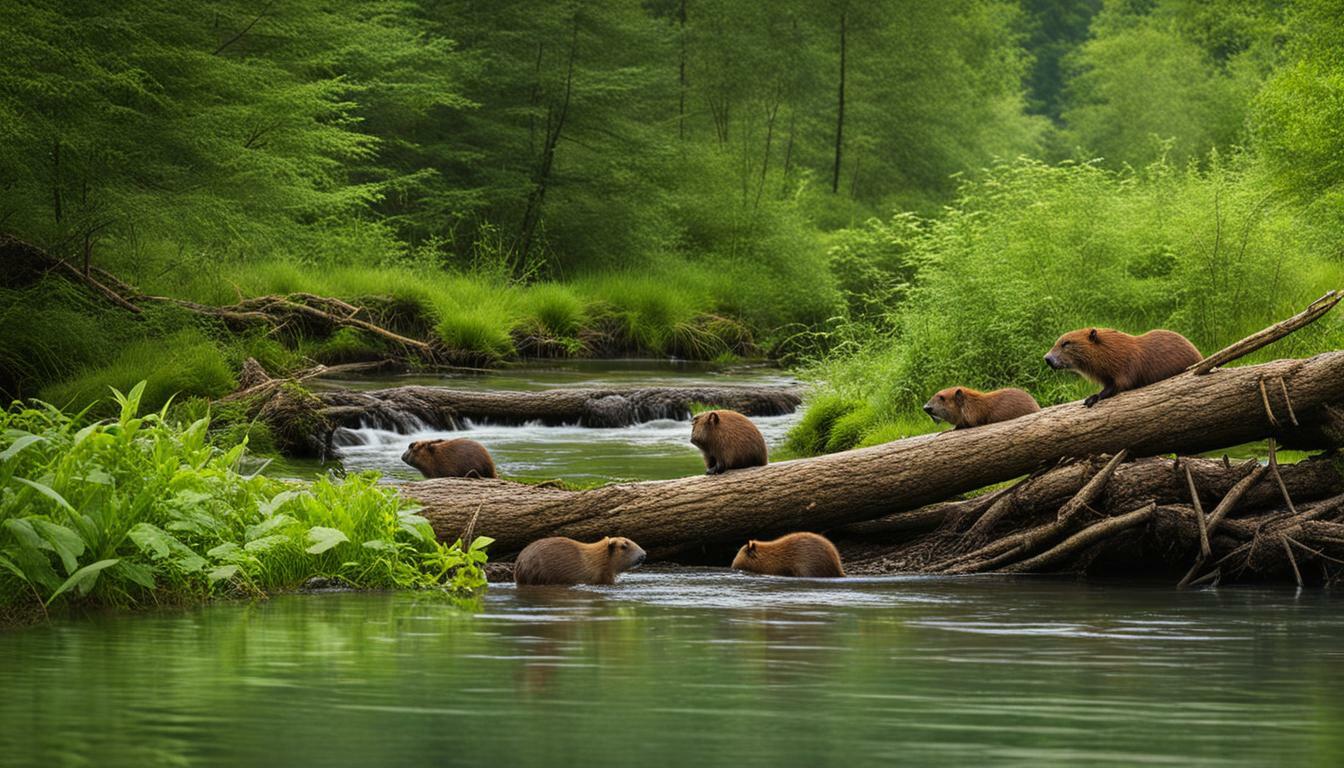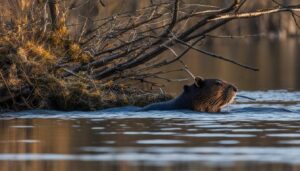Beavers are fascinating creatures known for their impressive ability to build dams. But why do they engage in this behavior? Let’s explore the reasons behind beavers’ dam-building behavior and their behavior in general.
Key Takeaways:
- Beavers build dams to protect themselves from predators and create a safe living environment.
- The dams serve the purpose of flooding areas to bring beavers closer to their food sources.
- Beavers are herbivores and primarily eat tree leaves, bark, and aquatic plants.
- They live in lodges built within the deep ponds created by the dams, not inside the dams themselves.
- Beaver dams benefit not only beavers but also other species by creating wetland ecosystems.
The Purpose of Beaver Dams
The main purpose of beaver dams is to provide protection and create a safe living environment for these industrious creatures. Beavers don’t actually live in the dams themselves; instead, they construct their lodges within the deep ponds created by the dams. These lodges provide shelter and safety from predators.
In addition to protection, beaver dams serve another important purpose – flooding. By creating these dams, beavers flood certain areas, bringing themselves closer to their food sources. Beavers are herbivores and primarily feed on the leaves of trees such as willows and aspens. They can also strip the bark from trees and consume aquatic plants found in the flooded areas.
The size and structure of beaver dams can vary, depending on the specific needs of the beaver family and the available resources in their habitat. Some dams can span several hundred feet, while others may be smaller and more compact. Beavers are skilled engineers, adapting their construction techniques to suit their surroundings.
| Key Points: | Beaver Dams |
|---|---|
| Dams provide protection and a safe living environment for beavers | Primary Purpose |
| Beavers build lodges within the deep ponds created by the dams | Living Arrangements |
| Dams flood areas to bring beavers closer to their food sources | Flooding for Food |
| The size and structure of beaver dams can vary | Adaptability |
Beavers’ Habitat Modification
Beavers are remarkable ecosystem engineers, altering their habitat through their dam-building activities. These industrious creatures construct dams using logs, branches, and mud, effectively creating deep ponds within which they build their lodges. These lodges provide safe and secure living spaces for beavers and their families.
One of the main purposes of beaver dams is to flood areas surrounding the pond, which brings beavers closer to their food sources. Beavers are herbivores, and they primarily feed on tree leaves, including those from willows and aspens. They also have the ability to strip the bark from trees and consume aquatic plants. By modifying their habitat to create these flooded areas, beavers ensure a readily available food supply.
In addition to serving their own needs, beaver dams have far-reaching effects on their environment. The creation of these dams helps to create wetland ecosystems, which are highly beneficial for various species. Wetlands provide essential habitat for a wide range of plants and animals, promoting biodiversity. Furthermore, these dams can slow down the flow of water, allowing it to be stored in the soil and reducing the impacts of drought and wildfires. Beaver dams also help improve water quality by filtering sediment and pollutants as water passes through the wetland.
| Benefits of Beaver Dams |
|---|
| Creates wetland ecosystems |
| Provides habitat for various species |
| Slows down water flow and stores water in the soil |
| Reduces the impacts of drought and wildfires |
| Improves water quality through sediment and pollutant filtration |
While beavers are primarily nocturnal, their behavior can vary depending on the presence of predators. They have developed various adaptations to help them survive in their environment. For example, beavers possess a comb-like structure on their hind feet, which they use for grooming their fur. This helps to keep their fur waterproof, enabling them to spend extended periods in the water.
It is important to coexist with beavers and take measures to mitigate any damage they may cause to property. By understanding the vital role that beavers and their dams play in shaping ecosystems and promoting environmental health, we can appreciate the valuable services they provide and find ways to peacefully share our habitats with these fascinating creatures.
The Size and Structure of Beaver Dams
Beaver dams can vary in size and structure, with each dam uniquely suited to the needs of the beaver family that builds it. These impressive structures are meticulously crafted using logs, branches, and mud, creating barriers that manipulate the flow of water and create deep ponds suitable for the beavers’ needs.
The size of a beaver dam can range from a few feet to several hundred feet long, depending on the availability of building materials and the size of the beaver family. Some larger dams can even reach heights of up to 5 or 6 feet. The structure of a beaver dam typically consists of a solid core made of mud and smaller branches, which is then reinforced with larger logs and sticks on the outer layers. This combination of materials makes the dam strong and resistant to water pressure.
In addition to the main dam, beavers also construct smaller dams known as “check dams” that help regulate water flow in the surrounding area. These check dams act as barriers to slow down the movement of water, allowing it to pool and create additional wetland habitats that benefit various species.
| Dam Size | Dam Structure |
|---|---|
| Varies | Logs, branches, and mud |
| Range from a few feet to several hundred feet long | Core of mud and smaller branches, reinforced with larger logs and sticks |
| Can reach heights of up to 5 or 6 feet | Contains solid core and outer layers for strength |
Ultimately, the size and structure of a beaver dam are carefully designed to create a suitable living environment for beavers and serve as a tool for modifying their habitat. By leveraging their remarkable engineering skills, beavers shape their surroundings to provide protection, access to food sources, and the creation of vital wetland ecosystems.
Benefits of Beaver Dams
Beaver dams offer a range of ecological benefits, making them vital components of natural landscapes. These impressive structures play a crucial role in creating wetland ecosystems, which provide habitat for a diverse array of species. Wetlands are known for their ability to slow down water flow, store water in the soil, and improve water quality, making them invaluable resources for maintaining healthy ecosystems.
One of the key functions of beaver dams is their ability to flood areas, bringing beavers closer to their food sources. By creating deep ponds behind their dams, beavers ensure a safe living environment for themselves and their family groups. These dams also provide protection from predators, as beavers do not actually live in the dams but construct lodges within the ponds created by the dams.
Not only do beaver dams benefit beavers directly, but they also have positive impacts on other species. Wetland habitats created by beaver dams attract a wide variety of wildlife, including birds, amphibians, reptiles, and mammals. These habitats offer nesting sites, food sources, and shelter, contributing to the overall biodiversity of the area.
| Ecological Benefits of Beaver Dams |
|---|
| Creation of wetland ecosystems |
| Improved water quality |
| Protection from predators |
| Increased biodiversity |
| Water flow regulation and storage |
| Reduction in the impacts of drought and wildfires |
By regulating water flow and storage, beaver dams also assist in water management. During periods of heavy rainfall, these dams act as natural reservoirs, preventing flooding downstream. In times of drought, the stored water can help maintain water levels, supporting plants and animals that rely on the wetland ecosystem.
It is important to recognize the ecological value that beaver dams bring and to coexist with these fascinating creatures. Taking measures to mitigate any damage they may cause to property, such as fencing off trees or redirecting water flow, allows us to appreciate the benefits of their presence while minimizing potential conflicts. Ultimately, embracing the ecological functions of beaver dams contributes to the preservation and enhancement of our natural environment.
Beaver Behavior and Adaptations
Beavers exhibit intriguing behavior and possess unique adaptations that enable them to thrive in their surroundings. These fascinating creatures are primarily nocturnal, meaning they are most active during the night. This behavior helps them avoid predators and carry out their activities undisturbed. However, the behavior of beavers can also be influenced by the presence of threats, altering their patterns of movement and feeding.
One of the remarkable adaptations of beavers is the presence of a comb on their back foot. This specialized comb is used for grooming their fur, ensuring it remains clean and waterproof. By keeping their fur well-groomed, beavers are able to stay warm in the cold water they inhabit. Additionally, their large, flat tail serves multiple purposes. It acts as a rudder while swimming and helps them maintain balance on land. The tail can also produce a loud slap on the water’s surface, serving as a warning signal to other beavers in the area.
When it comes to their diet, beavers are herbivores with a preference for tree leaves, particularly those of willows and aspens. They also consume the bark of trees and aquatic plants. Their sharp incisors allow them to cut through tree trunks and create the building materials necessary for dam construction and lodge building.
| Beaver Behavior and Adaptations | Key Points |
|---|---|
| Nocturnal Habits | Beavers are primarily active during the night, enabling them to avoid predators and carry out their activities undisturbed. |
| Specialized Adaptations | Beavers have a comb on their back foot for grooming fur and a large, flat tail for swimming, balance, and communication. |
| Herbivorous Diet | Beavers primarily eat tree leaves, bark, and aquatic plants, using their sharp incisors to cut through tree trunks. |
Understanding the behavior and adaptations of beavers provides valuable insights into their role as ecosystem engineers and their ability to shape their environment. By coexisting with these industrious creatures and implementing measures to mitigate any damage they may cause to property, we can ensure the preservation of both the species and the natural habitats they help create and maintain.
Beaver Diet and Food Sources
Beavers are herbivores and rely on a diet primarily composed of tree leaves, bark, and aquatic vegetation. Their specialized teeth and powerful jaws allow them to efficiently chew through woody vegetation. Beavers have a particular fondness for tree species such as willows and aspens, but they can also consume the bark of other trees. This unique diet makes them essential for the management of forest ecosystems.
When it comes to satisfying their hunger, beavers are known for their ability to fell trees with their sharp incisors. They then transport the branches and logs to their dams and lodges, where they can safely consume the nutritious tree parts. Eating the bark of trees not only provides beavers with essential nutrients, but it also helps control the growth of certain tree species, allowing for a more diverse forest ecosystem.
In addition to their love for tree bark, beavers also rely on aquatic plants for sustenance. They skillfully navigate through the water, using their streamlined bodies and webbed hind feet to swim efficiently. Once they reach their desired feeding location, beavers can dive underwater to search for and consume various aquatic vegetation, including water lilies, cattails, and sedges. Their ability to feed on both land and water makes them highly adaptable to their environment.
| Beaver Diet | Food Sources |
|---|---|
| Tree Leaves | Willows, Aspens, and other tree species |
| Bark | Tree species, including young and mature trees |
| Aquatic Plants | Water lilies, Cattails, Sedges, and more |
By consuming both terrestrial and aquatic vegetation, beavers play a crucial role in shaping and maintaining the balance of their habitats. Their feeding habits contribute to the creation of diverse and healthy ecosystems that benefit numerous other species within their environment.
Impacts on Other Species and the Environment
The presence of beaver dams has far-reaching positive effects on various species and the overall health of the environment. These ingenious structures created by beavers play a crucial role in creating and maintaining wetland ecosystems, which are incredibly biodiverse and provide habitat for a wide range of plants and animals. Let’s explore the ecological benefits that beaver dams bring:
1. Habitat Creation:
Beaver dams create unique wetland habitats that attract and support a diverse array of wildlife. The flooded areas behind the dams provide ideal conditions for amphibians, birds, and fish, as well as a multitude of plant species. Wetlands are vital for many species, serving as breeding grounds, feeding areas, and protective havens.
2. Water Management:
Beaver dams act as natural water managers, contributing to the regulation of water levels and flow. Their dams store water in the surrounding landscape, which helps prevent erosion and maintains water availability during dry periods. By slowing down water flow, beaver dams also reduce the risk of flooding downstream, which can be of great benefit to both humans and wildlife.
3. Water Quality Improvement:
Beaver dams play a crucial role in improving water quality. The dams trap sediment and filter runoff, allowing the water to naturally cleanse itself before it reaches downstream habitats. This process helps remove pollutants and nutrients, resulting in cleaner water and healthier ecosystems.
| Ecological Benefits of Beaver Dams |
|---|
| Habitat Creation |
| Water Management |
| Water Quality Improvement |
In conclusion, beaver dams have profound ecological benefits. They create invaluable habitats, contribute to water regulation, and improve water quality. By understanding and appreciating the positive impacts of these industrious creatures, we can work towards coexisting with them and implementing strategies to mitigate any potential property damage.
Coexistence and Mitigating Damages
It is crucial to find ways to coexist with beavers while taking appropriate measures to mitigate any potential property damage. Beavers play a vital role in shaping ecosystems and promoting environmental health, but their activities can sometimes conflict with human infrastructure and property. By understanding beaver behavior and implementing proactive strategies, we can strike a balance that benefits both humans and these industrious creatures.
One effective method for coexistence is the installation of flow devices. These devices regulate water levels and prevent excessive flooding caused by beaver dams. By controlling the water flow, property damage can be minimized while still allowing beavers to continue their natural behavior. Additionally, fencing can be employed to protect valuable trees and prevent beavers from accessing areas where their activities may result in harm.
The Importance of Educating Communities
Education plays a crucial role in fostering understanding and cooperation between humans and beavers. By raising awareness about the ecological benefits of beavers and the need for their conservation, communities can develop a more positive attitude towards their presence. This includes educating property owners on the value of beaver dams in creating wetland ecosystems and promoting water management. When people understand the role beavers play in maintaining healthy environments, they are more likely to embrace coexistence measures and minimize conflicts.
Furthermore, collaboration between wildlife management agencies, environmental organizations, and the general public is essential. By working together, we can develop comprehensive management plans that consider the needs of both beavers and humans. These plans may involve the relocation of beavers to suitable habitats, the implementation of exclusion devices to protect infrastructure, or the creation of designated beaver-friendly areas where they can thrive without causing significant human interference.
Achieving Balance and Preserving Nature’s Engineers
Coexisting with beavers requires a delicate balance between preserving their natural behaviors and protecting human interests. By implementing flow devices, utilizing fencing, educating communities, and fostering collaboration, we can mitigate property damage while ensuring the continued existence of these remarkable creatures. Let us remember that beavers are not merely pests, but ecosystem engineers that contribute to the health and diversity of our natural landscapes. Through respectful coexistence, we can appreciate and celebrate the vital role they play in shaping our environment.
| Coexistence Measures | Benefits |
|---|---|
| Installation of flow devices | Minimized property damage |
| Utilization of fencing | Protection of valuable trees and infrastructure |
| Educating communities | Raised awareness and understanding |
| Collaboration between agencies and public | Comprehensive management plans |
Beavers and Wetlands
Beavers are instrumental in the formation and preservation of wetland habitats, showcasing their significant contributions to the environment. Their unique dam-building behavior creates a network of interconnected ponds and wetlands that benefit a wide range of species. These wetlands not only provide essential habitat for plants and animals but also offer numerous ecological benefits.
The dams constructed by beavers help to slow down water flow, allowing sediment and nutrients to settle. This process improves water quality by filtering out pollutants and excess nutrients, resulting in healthier aquatic ecosystems. Additionally, the flooded areas created by beaver dams provide refuge and breeding grounds for various wildlife species, including birds, amphibians, and fish.
Wetlands are also crucial for water storage and regulation. During periods of heavy rainfall, beaver dams can store excess water, reducing the risk of flooding downstream. Conversely, during dry spells, these dams help maintain water levels by slowly releasing stored water into the surrounding environment. This function not only helps mitigate the impacts of droughts but can also reduce the severity and spread of wildfires by maintaining moisture levels in the surrounding vegetation.
Ecological Benefits of Beaver Dams in Wetlands:
| Benefit | Description |
|---|---|
| Habitat Creation | Beaver dams create diverse wetland habitats that support a wide array of plant and animal species. |
| Water Storage and Regulation | Beaver dams help store and slowly release water, mitigating the impacts of droughts and reducing the risk of flooding. |
| Improved Water Quality | The dams filter out pollutants and excess nutrients, resulting in healthier aquatic ecosystems. |
| Wildlife Refuge and Breeding Grounds | The flooded areas provide shelter and breeding grounds for a variety of wildlife species, including birds, amphibians, and fish. |
| Fire Mitigation | Maintaining moisture levels in surrounding vegetation can reduce the severity and spread of wildfires. |
Beavers and Water Management
The presence of beaver dams facilitates effective water management, offering various benefits such as water storage and regulation. Beavers are expert builders, constructing dams across streams and rivers by felling trees and collecting branches and mud. These dams create a barrier that slows down the flow of water, resulting in the formation of deep ponds behind the structures. These ponds serve as reservoirs, storing large amounts of water.
By regulating the flow of water, beaver dams help prevent flooding downstream during heavy rainfall and snowmelt. The dams act as natural buffers, absorbing excess water and maintaining more stable water levels over time. This is especially important in areas prone to flash floods or where water scarcity is a concern.
Benefits of Beaver Dams for Water Management:
- Water storage: The reservoirs created by beaver dams store water, which can be slowly released during periods of drought or used by surrounding vegetation.
- Water regulation: The dams regulate water flow, reducing the intensity of downstream flooding and preventing erosion.
- Groundwater recharge: The presence of beaver ponds allows water to seep into the ground, recharging groundwater aquifers and maintaining a sustainable water supply.
- Improved water quality: The slow-moving water in beaver ponds allows sediment and pollutants to settle, resulting in cleaner and clearer water downstream.
In addition to their role in water management, beaver dams contribute to the creation and maintenance of wetland ecosystems. Wetlands provide valuable habitat for numerous species, supporting a diverse range of plants, insects, birds, and mammals. These ecosystems play a crucial role in filtering pollutants, controlling erosion, and providing flood protection.
It is important to recognize and appreciate the positive impact that beavers and their dams have on water management and ecosystem health. By coexisting with beavers and implementing appropriate measures to mitigate any potential damage to property, we can harness the benefits of their remarkable engineering skills while preserving the delicate balance of our natural environment.
| Benefits of Beaver Dams for Water Management | |
|---|---|
| Water storage | The reservoirs created by beaver dams store water, which can be slowly released during periods of drought or used by surrounding vegetation. |
| Water regulation | The dams regulate water flow, reducing the intensity of downstream flooding and preventing erosion. |
| Groundwater recharge | The presence of beaver ponds allows water to seep into the ground, recharging groundwater aquifers and maintaining a sustainable water supply. |
| Improved water quality | The slow-moving water in beaver ponds allows sediment and pollutants to settle, resulting in cleaner and clearer water downstream. |
Conclusion
Beavers and their dam-building activities are essential for the ecological balance and well-being of various species and their habitats. These industrious creatures construct dams to protect themselves from predators and create a safe living environment. Although they don’t actually live in the dams themselves, beavers build lodges within the deep ponds created by their dams.
The purpose of beaver dams goes beyond mere protection. They serve to flood areas, bringing beavers closer to their food sources. As herbivores, beavers primarily consume the leaves of trees such as willows and aspens, but they can also strip the bark from trees and eat aquatic plants.
The size and structure of beaver dams can vary, as they adapt to their surroundings. These dams provide numerous benefits to not only beavers but also other species. By creating wetland ecosystems, beaver dams offer habitat for a diverse range of wildlife. Additionally, wetlands help slow down water flow, store water in the soil, reduce the impacts of drought and wildfires, and improve water quality.
While beavers are primarily nocturnal, their behavior can change based on the presence of predators. These resourceful creatures have adaptations that aid in their survival, such as a comb on their back foot for grooming their fur. It is crucial to coexist with beavers and implement measures to mitigate any damage they may cause to property, ensuring a harmonious relationship between humans and these important ecosystem engineers.
FAQ
Why do beavers build dams?
Beavers build dams to protect themselves from predators and create a safe living environment.
Do beavers live in the dams?
No, beavers actually live in lodges that they build within the deep ponds created by the dams.
What do beavers eat?
Beavers are herbivores and primarily eat the leaves of trees such as willows and aspens. They can also strip the bark from trees and consume aquatic plants.
How do beavers benefit other species?
Beaver dams create wetland ecosystems that provide habitat for many different species and can help improve water quality, store water in the soil, and reduce the impacts of drought and wildfires.
Are beavers nocturnal?
Yes, beavers are primarily nocturnal, but their behavior can vary depending on the presence of predators.
What adaptations do beavers have?
Beavers have a comb on their back foot for grooming their fur, which helps them survive in their environment.
How can one coexist with beavers?
It is important to coexist with beavers and take measures to mitigate any damage they may cause to property.




